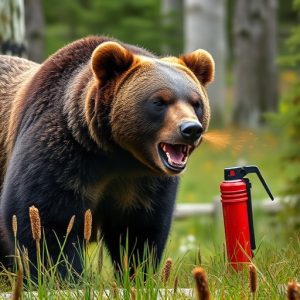Mastering Alaska Bear Repellents: Gear, Spray, and Safety Tips
Hikers exploring Alaska's wild terrain must carry bear spray, containing capsaicin (10-25%) for…….
Hikers exploring Alaska's wild terrain must carry bear spray, containing capsaicin (10-25%) for eye and respiratory irritation. Choosing the right spray involves understanding active ingredient percentages, with 15-20% capsaicin recommended. Proper application techniques, including spraying face-on at close range, are crucial. Alaska's regulations mandate specific minimums, emphasizing safe usage over absolute protection. Regular practice enhances hikers' ability to defend against bears while enjoying the state's landscapes.
As you venture into Alaska’s stunning landscapes, navigating its wilderness requires an understanding of potential risks, especially from bears. This guide explores the essential hiking gear: bear spray. We decipher the significance of bear spray active ingredient percentage, helping you choose the right repellent for your adventure. Learn application techniques to ensure maximum effectiveness and understand legal considerations unique to Alaska. Armed with knowledge, you’ll hike with confidence, knowing how to protect yourself in bear country.
- Understanding Bear Spray: The Essential Hiking Companion
- Decoding Bear Spray Active Ingredient Percentage: What Does It Mean?
- Choosing the Right Bear Repellent Gear for Your Adventure
- Application Techniques to Maximize Effectiveness
- Legal and Safety Considerations for Bear Spray in Alaska
Understanding Bear Spray: The Essential Hiking Companion
Bear spray, an essential tool for hikers navigating Alaska’s wild landscapes, is a powerful deterrent designed to protect against aggressive bears. Comprising capsaicin, a primary active ingredient derived from chili peppers, bear spray creates a painful and irritating experience for bears upon contact or inhalation. The typical concentration of this active ingredient in bear spray ranges between 10% and 25%, ensuring its effectiveness in deterring both black and grizzly bears.
Understanding how bear spray works is crucial for hikers. When sprayed, the capsaicin irritates a bear’s eyes, nose, and respiratory system, temporarily blinding and disorienting it. This provides hikers with a precious moment to retreat or seek safety. Proper usage involves aiming for the bear’s face and eyes, ensuring the spray reaches its target even in windy conditions. With regular practice, hikers can learn to deploy bear spray effectively during encounters, making their adventures in Alaska’s beautiful but bear-inhabited areas safer and more enjoyable.
Decoding Bear Spray Active Ingredient Percentage: What Does It Mean?
When choosing bear spray, one of the most important factors to consider is the bear spray active ingredient percentage. This isn’t just about power; it’s about understanding what chemicals are in the spray and how they work. Common active ingredients include capsaicin, a derivative of chili peppers that irritates a bear’s eyes and nose, and tetrahydrofuran (THF), which disrupts a bear’s sense of smell.
The percentage refers to the concentration of these active ingredients in the solution. A higher percentage doesn’t always mean better; it depends on the specific ingredient and the bear species. For example, while 15% capsaicin might sound stronger than 10%, a lower concentration can still be effective against smaller bears like black bears. Always read product labels carefully to understand the active ingredient composition and ensure it’s suitable for the types of bears you’re likely to encounter on your hikes.
Choosing the Right Bear Repellent Gear for Your Adventure
When venturing into Alaska’s great outdoors, selecting the appropriate bear repellent gear is paramount for a safe and enjoyable hiking experience. The key to effective protection lies in understanding the active ingredients and their concentration levels. Bear spray, a popular choice, typically contains capsaicin, a chemical derived from chili peppers, which deters bears by irritating their eyes and respiratory system. Look for products with an active ingredient percentage of 15-20% for optimal effectiveness against both black and grizzly bears.
Factors like the length and type of hike, terrain, and season should influence your gear choice. For longer treks through dense bush or remote areas, a can of bear spray is essential. It’s highly portable and offers quick protection when encounters are most likely. Alternatively, for those who carry firearms, specialized bear repellent guns or devices that emit loud noises can be effective deterrents. Always ensure your chosen gear meets Alaska’s safety standards and consider carrying multiple forms of protection for added peace of mind.
Application Techniques to Maximize Effectiveness
To maximize the effectiveness of bear spray, it’s crucial to understand and employ proper application techniques. First, ensure you’re using a product with a high active ingredient percentage—typically 15-20% capsaicin, the primary irritant that discourages bears from approaching. Before heading into the wilderness, familiarize yourself with the recommended spraying distances and angles. Practice in safe environments to get a feel for how far the spray reaches and how quickly it dissipates. Always aim for the bear’s face and eyes—these areas are most sensitive to the irritant.
When faced with a potential encounter, stay calm and follow the 3-step rule: back away slowly while raising your arms to appear larger, then deploy the bear spray, and finally, drop to the ground and play dead if necessary. Consistent practice of these techniques can significantly enhance your safety during outdoor activities in bear country.
Legal and Safety Considerations for Bear Spray in Alaska
In Alaska, the use of bear spray is a vital component of hiking gear for anyone venturing into bear country. It’s important to note that bear spray is not 100% effective against bears, but it can provide a crucial window of protection. The state has specific regulations regarding the type and percentage of active ingredient in bear spray. Typically, bear spray should contain at least 15% capsaicin, the active ingredient derived from chili peppers, to be considered effective by many experts. Always check the label for the concentration and ensure it meets Alaska’s legal requirements before purchasing.
Safety considerations include proper usage techniques, such as can placement, target practice, and understanding wind conditions. It’s recommended to use bear spray as a last resort, when you’re within striking distance of a bear but still have an escape route. Additionally, maintaining awareness about local bear activity and following guidelines from park rangers is essential for responsible hiking in Alaska’s beautiful yet potentially dangerous wilderness.
When hiking in bear country, such as Alaska, equipping yourself with the right bear repellent gear is non-negotiable. Understanding the intricacies of bear spray, including its active ingredient percentage, application techniques, and legal considerations, ensures maximum effectiveness and safety during your outdoor adventures. Remember, knowledge is power when navigating potential encounters with these majestic yet potentially dangerous animals. Always choose high-quality gear and stay informed to fully enjoy Alaska’s wilderness responsibly.


